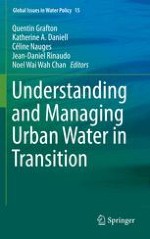2015 | OriginalPaper | Chapter
10. Investing in the Water Infrastructure of Tomorrow
Authors : David R. Marlow, David J. Beale, Stephen Cook, Ashok Sharma
Published in: Understanding and Managing Urban Water in Transition
Publisher: Springer Netherlands
Activate our intelligent search to find suitable subject content or patents.
Select sections of text to find matching patents with Artificial Intelligence. powered by
Select sections of text to find additional relevant content using AI-assisted search. powered by
